August Krogh
Article

Schack August Steenberg Krogh – A versatile genius
by Jan Lindsten*
2 April 2001
“The physiologist’s physiologist”
In 1997, at the Sixteenth Nordic Congress of Medical History in Stockholm, Dr. Ole Munck – consultant at the Museum of Medical History in Copenhagen, concluded his presentation about August Krogh with the following comment: “We are facing a versatile genius: from bicycle to cyclotron, from diffusion of air components to active sodium transport, from physiology at the high school level to insulin production.
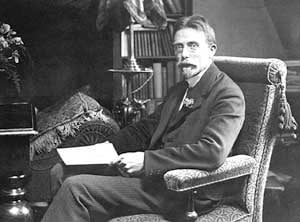
August Krogh in 1920 with his Nobel diploma on the table at the left.
Photo: Courtesy of Agnes Krogh Lindberg, daughter of August Krogh
Independently of what he dealt with, something came out of it … Krogh has described Niels Stensen, who lived 300 years ago, as Denmark’s greatest biologist. Maybe Krogh has taken over this standing.” This statement is in no way an expression of Danish patriotism, which is clear among other things from the symposium held in Copenhagen in 1969 to celebrate the 50th anniversary of August Krogh’s first works about capillary physiology. His former student and colleague Eugene Landis quoted the following from Man’s Unconquerable Mind by Gilbert Highet: “There are men who express the age and the milieu in which they are educated but who, by the intensity of their imagination, the sweep of their knowledge and their astounding versatility, rise above their era and their neighbors so that they inhabit both time and eternity at once. When we analyze their minds, we can identify nearly all the component elements tracing this to family and that to school and the other to social climate and yet the compound is far more than the sum of all these elements; richer, intenser, different in quality as a diamond is different from carbon.” Then Landis added: “For Professor Krogh, however, I enjoy the thought that even this metaphor can be extended.”
The same spirit is found in a 1967 editorial in the Journal of the American Medical Association (JAMA) with the impressive heading “August Krogh (1874-1949). The physiologist’s physiologist”.
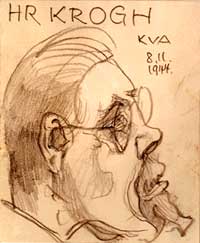 |
Caricature of August Krogh produced by Carl Benedickt in 1944. Photo: Courtesy of the Royal Swedish Academy of Sciences |
In the following, I shall try to elucidate what may be behind statements of such an admiring nature, in light of Ole Munck’s comment: “The exciting thing about geniuses is the areas where they cross borders, which others only can reach the nearness of. Where is it that Krogh did the great leap in his line of thinking? How did he arrive at it?”
Brief background
August Krogh was born in Grenå on Denmark’s Jutland peninsula in 1874. His father was a shipbuilder, but since the age of wooden ships was in decline, he instead switched to operating a small brewery. As a child, August Krogh found learning extremely easy and had an unusually inventive and inquiring mind. By the age of 12, for example, he had already studied two extensive reference works very thoroughly, The Book of Discoveries (seven volumes, 4,288 pages, 2,115 figures) and The Forces of Nature (three volumes, 1,508 pages, 868 figures). Not only this, but using simple means he also repeated many of the chemistry and physics experiments described in these books.
His great interest was animals, especially insects, which he collected and whose behavior he studied with great insight. This deep interest was strongly encouraged by a close friend of the family, William Sørensen, a passionate but slightly eccentric zoologist who eventually managed to earn his doctorate but never received any permanent academic post – he was too controversial a person for that.
August Krogh earned his upper secondary school diploma at the Cathedral School of Århus in 1893 with great self-confidence but also with top marks. By then he had already decided to become a researcher. Aside from zoology, his great interests were mathematics and physics. He was initially hesitant as to which of these subjects he should specialize in, but he finally chose zoology. His choice seems to have been partly influenced by William Sørensen. Out of respect for his father, he never dared to explain and persuade him in person of the wisdom of this choice, but instead did so by letter. This letter contained an exhaustive analysis of his own interests and character traits as well as the future prospects in various professions. It ended as follows: “When I say that I can not live without zoology, it is an exaggeration, and when I say that I do not want to live without zoology, you can look upon it as a fancy and, when I persist in doing so, as restiveness, and yet both aspects are in principle true.”
In 1895, he chose to specialize in zoophysiology after listening for the first time to a lecture by the prominent human physiologist Christian Bohr (father of Niels Bohr, 1922 Nobel Laureate in Physics). Otherwise Krogh believed, characteristically, that he could learn far more from practical work than from lectures and studies (probably because he had already mastered the topics of the lectures and was a born experimenter).
Krogh applied to Bohr’s department and was accepted as an assistant in the autumn of 1897. Although he had performed numerous and rather advanced home experiments (for example on the ability of Corethra larvae to regulate their capacity to rise and sink in water aided by closed air bladders), this year marked the beginning of his actual scientific career.
A monumental contribution to research in integrative physiology
To begin with, Krogh continued his studies of Corethra larvae. He constructed a device that could analyze the composition of the air in their bladders (0.03 mm3). He used it to show that the air bladders did not contain oxygen but almost exclusively nitrogen and to explain how their pressure regulation system worked. The air pressure in the bladders rose when water was absorbed into them and air was diffused out. Analogously, air diffused into the bladders when water was reabsorbed out of them.
Bohr soon became aware that Krogh had a natural aptitude for laboratory work. Krogh set up his experiments in a simple way and constructed the necessary equipment with extraordinary skill. This equipment was often so ingenious that only Krogh himself could operate it. So Bohr gave him a free hand in furnishing the laboratory, despite his youth.
Together with Bohr, in 1904 Krogh published a work demonstrating that carbon dioxide reduces the capacity of hemoglobin to bind oxygen. All at once, they had managed to explain how the blood transports and releases oxygen to tissues. The discovery became known as the Bohr effect but was based entirely on equipment that Krogh had designed, which made it possible to measure the oxygen-binding capacity of blood.
Meanwhile, Krogh had traveled to Greenland in 1902. In conjunction with this trip, he had developed an improved device (tonometer) that made it possible to measure the carbon dioxide content of seawater. Works that he published in 1902 discussed the role of seawater in buffering the carbon dioxide content of the atmosphere (Krogh – and before him in 1896 Svante Arrhenius, 1903 Nobel Laureate in Chemistry – thus dealt with the question of the greenhouse effect, which of course remains equally relevant today).
The collaboration between Bohr and Krogh thus began well, but it ended in disaster. Earlier, Bohr had performed measurements showing that the oxygen content of arterial blood was higher than that of the alveoli in the lungs. He therefore assumed, as did all the other main authorities in this field at the time, that oxygen was actively transported from the alveoli of the lungs into the blood. Krogh did not believe this (in his 1903 dissertation, he had studied gas exchange via the skin of frogs – an important part of their breathing – and found that it was a matter of passive diffusion). In 1904 he constructed his famous microtonometer, which made it possible to determine the gas content of blood with great precision.
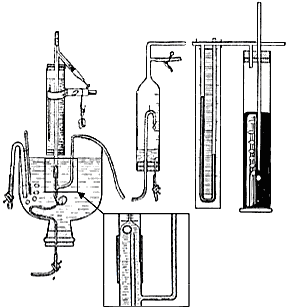
Microtonometer constructed by August Krogh for determining the oxygen and carbon dioxide content of blood.
Illustration: from Skan. Arch. Physiology
Copyright © Acta Physiologica Scandinavica
The gas content was measured in a small air bubble, no larger than 3-4 microliters, before and after absorption of gases. In other words, unlike his predecessors, his trick was to use a very small volume of gas instead of a large volume. This was because it quickly achieved equilibrium with the gas content of blood, for example. As early as 1906, Krogh found that there was no difference between the oxygen content of blood and the alveoli, thus leading him to believe that the passage of oxygen into the blood is a passive diffusion process. On April 22, 1907 he demonstrated his device and his measurement results to Christian Bohr. The demonstration was successful, but from that day onward, Bohr never spoke to Krogh again. His own student had shattered his authority.
Only in 1910 did Krogh publish his findings in a series of seven works (“the seven little devils”). Krogh lectured his former mentor, explaining why it had been difficult to arrive at the correct conclusion with the techniques that were used previously. But his conclusion was mercilessly, crystal clear: “The absorption of oxygen and the elimination of carbon dioxide in the lungs take place by diffusion and by diffusion alone. There is no trustworthy evidence of any regulation of this process on the part of the organism”.
In March 1999, I interviewed August Krogh’s then 81-year-old daughter (Bodil Schmidt-Nielsen). I asked why he had delayed publication of these findings, and why he had formulated them in the way he did. She explained that her father had agonized a great deal before publication. First, he absolutely wanted to avoid harming Bohr, a man he revered and to whom he owed a great debt of gratitude. Second, he wanted to be sure that publication of his findings would not destroy his own future as a researcher. But the truth needed to come out, so all other considerations had to be put aside (Christian Bohr died in 1911).
While establishing that the movement of gases between the alveoli and the blood occurs through passive diffusion did put an end to a lengthy debate, the solution of this problem was not what won August Krogh the Nobel Prize in Physiology or Medicine. “Settling a question in dispute, whose relations and implications are known in advance, should hardly be considered a discovery,” said J. E. Johansson in his presentation speech about Krogh at the 1920 Prize Award Ceremony. Krogh won the prize for dealing with a completely different problem and making what one can speak of as a genuinely new discovery. Or to quote Professor Johansson’s presentation speech: “Several scientists saw the capillaries change in response to various stimuli. But none of them thought of investigating whether these phenomena could be related to a new mechanism.”
When the body performs work, this greatly increases its need for oxygen, especially in the muscles, but the question was where this increased oxygen supply came from. The capillaries had been known for 250 years. The conventional view was that they all stood open. It was assumed that the speed of blood flow increased during work. Krogh’s mathematical calculations indicated that this could not be true. Faster blood flow through the capillaries hardly increased the potential for more oxygen supply, because the time for diffusion meanwhile decreased. Instead, Krogh elegantly and clearly demonstrated (by measurements of the oxygen content in capillaries and muscle fibers, direct observations and histological sections) that a relatively small number of capillaries are open during rest. In fact, capillaries are opening and closing all the time. During work, however, more capillaries are open. He also found that capillaries can vary in diameter and are thus independently contractile. Although the speed of blood flow through the capillaries is the same during rest and work, the oxygen supply increases because so many capillaries are open and each capillary can hold more blood.
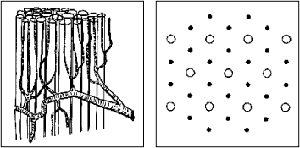 |
| Schematic drawing of a piece of muscle with a small artery and capillaries (above, left). Open and closed capillaries in a cross-section of a muscle (above, right). |
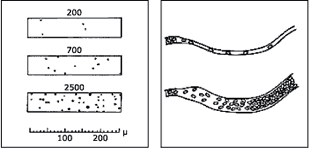 |
| Cross-section (above, left) of vital injection preparations of muscles at rest (top) and after hard work (bottom) from a guinea pig. Capillaries (above, right) in the tongue of a frog before (above) and after (below) mechanical irritation. Figures: from Krogh’s Nobel Lecture Copyright © The Nobel Foundation |
Krogh carried out his investigations of capillaries in the form of a long series of animal experiments. His first findings were published in a Danish journal in 1918 and in English-language journals in 1919. Because Krogh received the Nobel Prize in 1920, the faculty of Karolinska Institutet lived up to the wording of Alfred Nobel’s will that the discovery awarded the prize is to have been made during the preceding year. This has not always been the case.
In 1922, Krogh summarized his own work on capillaries and that of others in a monograph (now published in several editions) about which Eugene Landis says, “Very few books yielded as prompt and as widespread stimulation of research as this monograph did when it was read by histologists, physiologists, pathologists and clinicians.” It is also worth recalling that August Krogh was a natural scientist, not a medical doctor.
The Nobel Prize improved Krogh’s working conditions from many standpoints, but it did not influence his scientific activity in any way. He concluded his Nobel lecture with the words “I will do everything within my power to appear worthy of the confidence that Karolinska Institutet has bestowed upon me”. And he genuinely lived up to this, because he continued to work assiduously as a researcher until his death in 1949.
Both before (from the time he got his own laboratory in 1910) and after receiving the Nobel Prize, Krogh worked in the field of exercise physiology. Together with his colleague, the exercise physiologist Johannes Lindhard, he started this whole field of research in Scandinavia during the years 1910-1915. As part of this work, he developed his famous automatically controlled bicycle ergometer (1910-11).
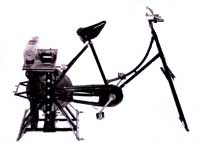
Automatically controlled bicycle ergometer from 1913, designed by August Krogh.
Photo: Courtesy of Dr. Ole Munck, Museum of Medical History, Copenhagen
This was not actually an original discovery, but an improvement of an earlier model. But it was not just any improvement. The accuracy with which this device could study the effect of exercise was amazing, and the ergometer is thus still being used today (in 1997 in Copenhagen alone, five were in use). A special ergometer that was suspended (including the person being tested) from a balanced system in the ceiling was used to measure weight changes during exercise.
 |
 |
Healthy experimental subject (above, left) working out on a suspended bicycle to allow measurement of small weight losses caused, for example, by perspiratio insensibilis. The change in body weight is read manually on the curve recorded on the drum (above, right).
Photos: Courtesy of Professor Bodil Johannsen
The equipment was designed by August Krogh and his colleagues around 1936 and is still in use today. It was so accurate that it could record a loss of one gram in 20 seconds. This device, too, is still in use, like so many other devices that Krogh designed.
Among all of Krogh’s other scientific works, there is reason to mention that he demonstrated that the muscles burn fat during exercise, which had previously been denied by the authorities in the field, for example the French physiologist Auguste Chauveau. This may not seem so sensational, but considering that this is the background for understanding the role of exercise in health, this discovery assumes a larger dimension.
Krogh’s scientific work during the final years of his life dealt with the energy metabolism of insects in flight. Once again, he designed ingenious methods to study this problem, among them his spectacular grasshopper carousel (grasshoppers were suspended in a carousel, located in a closed chamber with circulating air that stimulated the grasshoppers to fly, after which their energy and oxygen consumption could be determined).
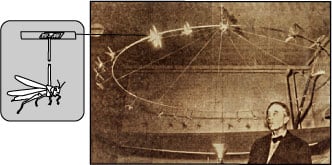 |
| August Krogh and his grasshopper carousel. Copyright © Berlingske Tidende |
Practical applications of research findings
To August Krogh, it was important that research findings with the potential for practical applications were also used in society. He personally introduced physiology as a subject of instruction in the upper secondary schools and wrote a textbook especially adapted for this.
He was also interested in the residential environment. He designed a climate chamber (with about the same diameter as a large coin, but somewhat thicker) that people could carry on their body to record humidity and temperature continuously for a 24-hour period.
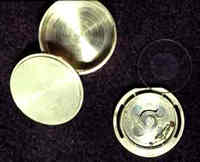
Climate chamber for continuous recording of temperature and humidity under a person’s clothing for 24 hours, designed by August Krogh in 1938-39. (Boligopvarmningsudvalgets meddelelse nr. 5, Copenhagen, 1948)
Photo: Courtesy of Dr. Ole Munck
Together with Niels Bohr (1922 Nobel Laureate in Physics) and George de Hevesy (1943 Nobel Laureate in Chemistry) – who worked in Copenhagen for a few years in the 1930s – Krogh also introduced the use of radioactive isotopes in biological research. A cyclotron had been installed in Copenhagen as early as 1938 with funding from the Rockefeller Foundation.
 |
August Krogh (center) together with Hans von Euler-Chelpin (left) and Georg de Hevesy (right) – 1929 and 1943 Nobel Laureates in Chemistry, respectively – during a 1945 visit to Stockholm. Photo: Courtesy of the Niels Bohr Archive, Copenhagen |
Without Krogh, it is likely that biologists would not have realized the importance of isotopes for their research at such an early stage.
Perhaps his most important contribution in this context, however, concerns the manufacture of insulin. August Krogh’s wife Marie Krogh, a physician and his research colleague, had become ill with diabetes (the diagnosis was probably made in 1921). She was treated with a special diet by the young physician Hans Christian (H.C.) Hagedorn. The Nobel Prize had made August Krogh internationally famous, and in 1922 he and his wife traveled to the United States. Sitting beside well-known diabetologist Eliot P. Joslin at a dinner, Marie Krogh learned from him that a research group in Toronto had succeeded in isolating insulin. Marie persuaded her husband to extend their visit to Toronto. On November 23-25 they were guests in the home of John Macleod (1923 Nobel Laureate in Physiology or Medicine together with Frederick Banting). When the Kroghs returned to Copenhagen on December 12, they carried with them a license to manufacture insulin. As early as December 21, the first laboratory experiments were made and on March 13, 1923 the first patient was treated. Together with H.C. Hagedorn, August Krogh established the Nordic Insulin Laboratory, which was the starting point of a Danish pharmaceutical company that remains highly successful today. However, August Krogh soon withdrew from the business and returned to his research. His wife Marie was treated with insulin and lived until 1943, when she died of breast cancer (until then, their children knew nothing about her diabetes).
Driving forces
On October 28, 1920, during the birthday celebration of the University of Copenhagen, journalists began pouring into the room where the event was taking place. They asked, among others, the members of the faculty of medicine where they could find Professor Krogh, who had just won the Nobel Prize. The reply was: “It must be a mistake, there is no Professor Krogh here.” By the time the matter was finally sorted out, and a speech of congratulations was held, August Krogh had already disappeared from the room.
Who was this August Krogh that no one knew?
He was a genuine biologist, with an extreme curiosity. He devoted his whole life to trying to understand biological, and especially physiological, phenomena – day and night (he even conducted experiments on his wedding day). His daughter, Bodil Schmidt-Nielsen, told me that her father was always working but that he was never pressed by his work. Of all the Krogh family photographs in existence, one motif reappears time after time: August Krogh sitting and discussing scientific work with his wife Marie. She was thus highly important to him in that context as well.

August and Marie Krogh in 1935.
Photo: Courtesy of Agnes Krogh Lindberg, daughter, who also took the photograph
He appreciated problems and was stimulated by challenges, but he was never satisfied with stating that there was a problem. Instead he wanted to find an explanation for the phenomena he had observed. Because the truth had to be revealed, his problem-solving had to be based on exact measurements and mathematical calculations. This explained his great interest in the construction of equipment. In such situations, his sound knowledge of physics and mathematics served him well. Danish writer Piet Hein’s Gruk, originally written in English,
“Problems worthy of attack,
Show their worth by fighting back”
sums up Krogh’s attitude toward problem-solving rather well. Krogh said that he had always learned more from practical work than from lectures. Reading too much increased the risk of being influenced by authority and could therefore have a restraining effect. “Be always prepared to reject or modify a hypothesis, if an experiment shows something unexpected.” The following statement from Professor Hans Ussing, a former student of August Krogh, represents the attitude toward flexibility that Krogh supplied to his students: “If Krogh can make a mistake, then we can too…”
In addition, Krogh had an unfailing intuition in choosing the right problem (that is, problems of fundamental importance), the right solution and the right experimental organism (“For many problems there is an animal in which it can be most conveniently studied” – the August Krogh principle) as well as an unusually good, almost pedantic talent for planning and an irrepressible drive. His establishment of insulin production in Denmark demonstrates this especially well. The current head of the August Krogh Institute, Professor Erik Hviid Larsen, says that Krogh knew how to proportion questions and their solutions and had an enormous talent for evaluation.
Add his need for scientific honesty and firm principles, and it is understandable that Krogh had many admirers, but not only friends. He was something of an “either-or person” and sometimes broke with people, yet he was able to separate the issue from the individual.
As mentioned, Krogh was rather introverted, shy and modest. He declined positions of honor, because they took away too much time from his research, and he steered clear of attention and publicity. But not always. He was capable of taking advantage of his position to generate publicity, for example when he resigned from the Royal Danish Academy of Sciences and Letters in 1949. He did so because he felt that the Academy was far too conservative and, among other things, unwilling to implement the reform proposals he had introduced, for example when it came to investing more in young researchers.
What about prestige, status and personal finances? Bodil Schmidt-Nielsen told me with a smile that Krogh did not need to seek prestige and status – he had them. As for finances, his demands were relatively modest. He wanted to live close to his institute, and the institute should not be too large. The funds that flowed in from various inventions, the sale of equipment and the production of insulin should be used entirely for research.
Working methods
As mentioned, Krogh was stimulated by biological problems. He wanted to find solutions to them, and these should always be based on accurate measurements. And he accomplished this in a very special way, which he called visual thinking. He described it as follows: “A considerable part of my work was done in bed during the night when I would try to visualize the processes studied and the experiments to be carried out. I found that I could visualize fairly complicated apparatuses and all details of their working. The constructive ideas would come, apparently, out of nowhere, but the visionary examination of them was a conscious and rational affair. I never made, and even now never make, drawings, not even rough sketches, until the construction of an apparatus was complete, because I found that a drawing would hamper the free flow of ideas and bind me down to that particular solution of the problem.”
Besides having knowledge of mathematics and physics that was useful in this context, Krogh also had a very practical bent. His devices were ingeniously designed for specific purposes, and it was very much a matter of precision technology. To enable him to develop these instruments, he had access to a large workshop employing a number of people with whom he had a very close working relationship, yet he often built devices himself. After all, he had already worked them out and tested-operated them in his own mind.
H.C. Hagedorn has described Krogh’s working method as follows: “He often utilized rather simple experimental arrangements, making use of glassware which he had blown himself and which were fixed with modeling clay or something similar in a very primitive way. When he had to change or correct something in these simple devices, his slender hands approached them with remarkably few and slow movements, which resulted in the effect wanted with amazing skill. Sometimes the arrangements were such that hardly anyone except himself had the ability to use them. In contrast, apparatuses for permanent use were thoroughly gone through.”
Krogh very much appreciated the atmosphere and working methods he had experienced during his happy years with Christian Bohr. As a result, he always wanted his home to be right next to his laboratory, so that he could go there at any time – when thoughts popped up – or talk to his colleagues. He did not want his institute to be too big, because he always had at least one project in common with each of his colleagues. Aside from visiting them occasionally outside of working hours, he dropped in on each of them every morning to talk and find out how things were going. He was pleased when they were going well, but usually even more pleased if complex problems had arisen. It is easy to understand why he was enormously well-liked by his colleagues and his many guests researchers over the years.
August Krogh created an institute that is still very much alive and that has produced many prominent researchers. Integrative physiology was his life interest. This is why all types of physiology, including human physiology, are still being pursued at the August Krogh Institute in Copenhagen.
Epilogue
August Krogh died of cancer on September 13, 1949. Among the books he read toward the end of his life was 100 Dikter (100 Poems) by the Swedish poet Hjalmar Gullberg (late during World War II, Krogh had spent some time in exile in Sweden). One day, he showed his daughter, Bodil Schmidt-Nielsen, the poem he was reading, “Efterlyses” (Wanted) in which the author searched for his lost childhood faith and promised a reward to anyone who could find it.
Acknowledgements
The author gratefully thanks August Krogh’s daughters Bodil Schmidt-Nielsen and Agnes Krogh Lindberg for a very interesting and informative interview and for the photographs used in some of the figures, respectively; Dr. Ole Munck of the Museum of the History of Medicine in Copenhagen for stimulating discussions and for the photographs used in several of the figures; Professors Bodil Johannesen and Bengt Saltin at the August Krogh Institute in Copenhagen for providing photographs of the suspended bicycle; The Niels Bohr Archive in Copenhagen for allowing me to use the photograph of Krogh, von Euler-Chelpin and Georg de Hevesy; Acta Physiologica Scandinavica for permission to reproduce drawings of the microtonometer; the Center for History of Science at the Royal Swedish Academy of Sciences for permission to publish the caricature of August Krogh drawn by the late Professor Carl Benedickt; and the Nobel Assembly at Karolinska Institutet for letting me study the archive material concerning August Krogh.
References
“August Krogh (1874-1949), the physiologist’s physiologist” (editorial). JAMA, 1967, 199, 156-157.
Deckert, T.: Dr. med. H. C. Hagedorn og det danske insulin-eventyr (Dr. H.C. Hagedorn and the Danish Insulin Adventure), Poul Kristensens Forlag, Copenhagen, 1998.
Alfred Benzon Symposium II, 1970.
Les Prix Nobel en 1919-1920, P.A.Norstedt & Söner, Stockholm, 1922.
Munck, O.: “August Krogh – Nobelpristagare i fysiologi eller medicin 1920” (August Krogh – 1920 Nobel Laureate in Physiology or Medicine), Svensk Medicinhistorisk Tidskrift, 1997, 1, 85-90.
Schmidt-Nielsen, B: August and Marie Krogh. Lives in Science, Oxford University Press, New York, 1995.
* August Krogh was awarded the Nobel Prize in Physiology or Medicine in 1920 “for his discovery of the capillary motor regulating mechanism.” During the 1939-40 Winter War between the Soviet Union and Finland, when the Danes began collecting money in support of Finland, August Krogh was urged to donate his Nobel medal, which was made of solid gold, for this purpose. He did so, but first he had his daughter Bodil Schmidt-Nielsen make a copy of the medal in silver, which was then gold-plated.
Jan Lindsten (b. 1935) obtained his B. Sc. in 1958, Ph.D. in 1963 and M.D. in 1969. Since 1970 he has served as professor of Medical Genetics at Karolinska Institutet in Stockholm, was Dean of the Medical Faculty between 1996 and 1998, and Professor emeritus of this institute since 2000. Lindsten has served in various capacities at the Karolinska Hospital, Stockholm: head of the Department of Clinical Genetics between 1970 and 1990, chief medical officer between 1987 and 1990, and chief executive officer between 1990 and 1994. In 1994-1996 he was chief executive officer at the National University Hospital in Copenhagen, Denmark. Lindsten was secretary general of the Nobel Assembly and the Medical Nobel Committee as well as member of the board of the Nobel Foundation between 1979 and 1990. He is a member of the Swedish Royal Academy of Sciences and honorary member of the Finnish Medical Association.
Every effort has been made by the publisher to credit organizations and individuals with regard to the supply of photographs and illustrations. The publishers apologize for any omissions which will be corrected in future editions.
First published 2 April 2001
Nobel Prizes and laureates
Six prizes were awarded for achievements that have conferred the greatest benefit to humankind. The 14 laureates' work and discoveries range from quantum tunnelling to promoting democratic rights.
See them all presented here.
